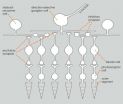(Press-News.org) WEST LAFAYETTE, Ind. - Hybrid plants with multiple genome copies show evidence of preferential treatment of the genes from one ancient parent over the genes of the other parent, even to the point where some of the unfavored genes eventually are deleted.
Brian Dilkes, an assistant professor of genetics at Purdue University, worked with a team of scientists at the University of California Davis and University of Southern California to study the genome of Arabidopsis suecica, a hybrid species with four chromosome sets formed tens of thousands of years ago from a cross between Arabidopsis arenosa and Arabidopsis thaliana, a plant commonly used in laboratories for genetic research. Dilkes said the findings, published in the journal Genome Biology and featured as an editor's choice article in the journal Science, give a glimpse into the evolutionary forces and ultimate fates of genes contributed by the two parents to a hybrid
"There often is no visible signature of these genes when we look at the plants with a microscope, but we can still observe those genes in the genome sequence," Dilkes said. "Moreover, the ability to make crosses between Arabidopsis thaliana and Arabidopsis arenosa gives us the opportunity to compare laboratory-derived plants that were generated yesterday with naturally occurring species from the wild and compare the two kinds of species hybrids. This is essentially allowing us an opportunity to 'replay the evolutionary tape,' in the words of Stephen J. Gould."
The researchers compared the genomes and gene expression among Arabidopsis suecica plants that have evolved over tens of thousands of years to similar species of hybrids made in the lab from fresh crosses.
When the contribution of genes from each parent was compared, they were not equal. One parent's genes were preferentially expressed at higher levels. In the cases where that happened, it was three times more likely that the preferentially expressed genes came from Arabidopsis arenosa.
The team also found that gene pairs that are co-expressed in similar tissues are preferentially expressed from the same parent. Even in the rare cases when an Arabidopsis thaliana gene was more abundantly expressed in the hybrid, co-expressed genes would also be preferentially expressed from the Arabidopsis thaliana copy.
"Our findings suggest an additional network dependence, where genes fine-tuned to work together within either parental species prior to hybridization are more likely to be expressed together in the hybrid. This, in turn, ensures that these genes acquired from one parental species are kept together and are not lost in the genome over time," said Peter Chang, a graduate student at USC and lead author on the paper. "Plants have had a remarkable ability to adapt to different conditions throughout Earth's history, and we are just beginning to understand some of ways this is done."
Previous work has shown that plant genomes with historical duplications from tens of millions of years ago have lost one of the two copies in large blocks along the chromosome, consistent with the preferential loss of one parent's contribution.
Dilkes said the retained genes may have a role in the plants' fitness but genes that weren't expressed would be deleted from the genome.
"The genome is moving toward a two-copy organization, a diploid, by preferentially deleting one parent. When others have looked at genomes that have ancient duplications they see large blocks of duplications in which one block has a large number of genes and the other has a sparse gene content," Dilkes said. "Perhaps a cause of this pattern in the organization of genomes is preferential expression, and, all other things being equal, the gene that is more abundantly expressed will carry a greater proportion of the fitness load for any essential function."
###
The National Science Foundation funded the research.
Writer: Brian Wallheimer, 765-496-2050, bwallhei@purdue.edu
Sources: Brian Dilkes, 765-494-2584, bdilkes@purdue.edu
Peter Chang, 213-821-4000, Peter.Chang@usc.edu
Abstract on the research in this release is available at: http://www.purdue.edu/newsroom/research/2011/110309DilkesScience.html
Study shows how plants sort and eliminate genes over millennia
2011-03-10
ELSE PRESS RELEASES FROM THIS DATE:
What's in a name? Broadening the biological lexicon to bolster translational research
2011-03-10
So-called model organisms have long been at the core of biomedical research, allowing scientists to study the ins and outs of human disorders in non-human subjects.
In the ideal, such models accurately recapitulate a human disorder so that, for example, the Parkinson's disease observed in a rat model would be virtually indistinguishable from that in a human patient. The reality, of course, is that rats aren't human, and few models actually faithfully reflect the phenotype of the disease in question. Thus, in the strictest sense of the word, many "models" aren't truly ...
Novel method could improve the performance of proteins used therapeutically
2011-03-10
FINDINGS: Whitehead Institute scientists have created a method that uses the enzyme sortase A to site-specifically modify proteins. Using this technique, researchers were able to increase potency, slow the metabolism, and improve thermal stability of several proteins, including interferon alpha 2 (IFN-alpha 2) and granulocyte colony-stimulating factor 3 (GCSF-3). IFN-alpha 2 is used to treat a variety of diseases, including leukemia, melanoma, and chronic hepatitis C, while GCSF-3 (known as filgrastim and marketed as Neupogen®) is administered to patients with neutropenia.
RELEVANCE: ...
First international index developed to predict suicidal behavior
2011-03-10
Although thousands of people commit suicide worldwide each year, researchers and doctors do not have any method for evaluating a person's likelihood of thinking about or trying to commit suicide. An international group of scientists, in which the Hospital del Mar Research Institute (IMIM) has participated, has devised the first risk index in order to prevent suicides.
"It is of key importance to identify suicidal thoughts among people at increased risk. The most important contribution that our study has made is an international risk index to estimate the likelihood of ...
More reasons to be nice: It's less work for everyone
2011-03-10
A polite act shows respect. But a new study of a common etiquette—holding a door for someone—suggests that courtesy may have a more practical, though unconscious, shared motivation: to reduce the work for those involved. The research, by Joseph P. Santamaria and David A. Rosenbaum of Pennsylvania State University, is the first to combine two fields of study ordinarily considered unrelated: altruism and motor control. It is to be published in a forthcoming issue of Psychological Science, a journal of the Association for Psychological Science.
"The way etiquette has been ...
Rutgers researchers identify materials that may deliver more 'bounce'
2011-03-10
NEW BRUNSWICK, N.J. – Rutgers researchers have identified a class of high-strength metal alloys that show potential to make springs, sensors and switches smaller and more responsive.
The alloys could be used in springier blood vessel stents, sensitive microphones, powerful loudspeakers, and components that boost the performance of medical imaging equipment, security systems and clean-burning gasoline and diesel engines.
While these nanostructured metal alloys are not new – they are used in turbine blades and other parts demanding strength under extreme conditions – ...
When leukemia returns, gene that mediates response to key drug often mutated
2011-03-10
(MEMPHIS, Tenn. – March 9, 2011) Despite dramatically improved survival rates for childhood acute lymphoblastic leukemia (ALL), relapse remains a leading cause of death from the disease. Work led by St. Jude Children's Research Hospital investigators identified mutations in a gene named CREBBP that may help the cancer resist steroid treatment and fuel ALL's return.
CREBBP plays an important role in normal blood cell development, helping to switch other genes on and off. In this study, researchers found that 18.3 percent of the 71 relapsed-ALL patients carried alterations ...
Gene variant influences chronic kidney disease risk
2011-03-10
A team of researchers from the United States and Europe has identified a single genetic mutation in the CUBN gene that is associated with albuminuria both with and without diabetes. Albuminuria is a condition caused by the leaking of the protein albumin into the urine, which is an indication of kidney disease.
The research team, known as the CKDGen Consortium, examined data from several genome-wide association studies to identify missense variant (I2984V) in the CUBN gene. The association between the CUBN variant and albuminuria was observed in 63,153 individuals with ...
New microscope decodes complex eye circuitry
2011-03-10
VIDEO:
Ganglion cells preferentially form synapses with those amacrine cells whose dendrites run in the direction opposite -- seen from the ganglion cell - to the preferred direction of motion (amacrine...
Click here for more information.
The sensory cells in the retina of the mammalian eye convert light stimuli into electrical signals and transmit them via downstream interneurons to the retinal ganglion cells which, in turn, forward them to the brain. The interneurons ...
Physicists measure current-induced torque in nonvolatile magnetic memory devices
2011-03-10
ITHACA, N.Y. - Tomorrow's nonvolatile memory devices – computer memory that can retain stored information even when not powered – will profoundly change electronics, and Cornell University researchers have discovered a new way of measuring and optimizing their performance.
Using a very fast oscilloscope, researchers led by Dan Ralph, the Horace White Professor of Physics, and Robert Buhrman, the J.E. Sweet Professor of Applied and Engineering Physics, have figured out how to quantify the strength of current-induced torques used to write information in memory devices ...
NASA and other satellites keeping busy with this week's severe weather
2011-03-10
Satellites have been busy this week covering severe weather across the U.S. Today, the GOES-13 satellite and NASA's Aqua satellite captured an image of the huge stretch of clouds associated with a huge and soggy cold front as it continues its slow march eastward. Earlier this week, NASA's Tropical Rainfall Measuring Mission satellite captured images of severe weather that generated tornadoes over Louisiana.
Today the eastern third of the U.S. is being buffered by a large storm that stretches from southeastern Minnesota east to Wisconsin and Michigan, then south through ...



